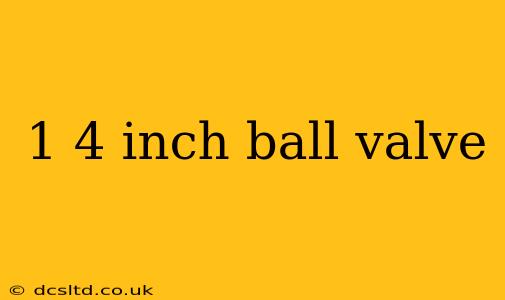A 1 1/4 inch ball valve is a crucial component in many plumbing, industrial, and even residential applications. Its compact design and reliable operation make it a popular choice for controlling the flow of liquids and gases. This guide will delve into the specifics of these valves, answering common questions and providing valuable insights for both professionals and DIY enthusiasts.
What is a 1 1/4 Inch Ball Valve?
A 1 1/4 inch ball valve is a type of quarter-turn valve that uses a spherical ball to control the flow of fluid. The "1 1/4 inch" refers to the nominal bore size—the diameter of the opening through which the fluid passes. This size is commonly used in various applications where a balance between flow capacity and compact size is needed. The ball's rotation (a quarter turn, hence "quarter-turn valve") opens or closes the valve, offering simple and quick on/off control.
What are the Different Types of 1 1/4 Inch Ball Valves?
Several factors differentiate 1 1/4 inch ball valves:
-
Material: They are manufactured from a wide range of materials, including brass, stainless steel, PVC, and CPVC. The choice of material depends on the application and the fluid being controlled. For example, stainless steel is ideal for corrosive fluids, while brass is a more cost-effective option for less demanding applications.
-
End Connections: These valves can have various end connections, such as threaded (NPT), flanged, or soldered connections. The selection depends on the piping system's type and requirements.
-
Handle Type: Ball valves can feature different handle types, including lever handles, T-handles, and ball handles. The handle type is often a matter of preference and ease of use in a specific setting.
-
Full-Port vs. Reduced-Port: Full-port ball valves have a flow path as wide as the valve's nominal bore size, offering minimal restriction to fluid flow. Reduced-port valves have a smaller flow path, leading to increased pressure drop.
What is the Pressure Rating of a 1 1/4 Inch Ball Valve?
The pressure rating of a 1 1/4 inch ball valve varies depending on the material, design, and manufacturer. This rating indicates the maximum pressure the valve can safely withstand without failure. Always check the manufacturer's specifications to determine the appropriate pressure rating for your specific application. Using a valve beyond its pressure rating can lead to dangerous leaks or ruptures.
Where are 1 1/4 Inch Ball Valves Used?
1 1/4 inch ball valves find applications across diverse industries and settings, including:
- Residential Plumbing: Controlling water flow to appliances, fixtures, and irrigation systems.
- Industrial Processes: Regulating the flow of fluids in manufacturing and processing plants.
- HVAC Systems: Controlling refrigerant flow in air conditioning and heating systems.
- Chemical Processing: Handling various chemicals and fluids requiring precise flow control.
How Do I Choose the Right 1 1/4 Inch Ball Valve?
Selecting the correct 1 1/4 inch ball valve involves considering several factors:
- Fluid Compatibility: Ensure the valve material is compatible with the fluid being controlled.
- Pressure Rating: Choose a valve with a pressure rating exceeding the expected operating pressure.
- Temperature Rating: Verify the valve's temperature rating aligns with the operating temperature.
- End Connections: Select end connections compatible with the existing piping system.
- Flow Requirements: Consider whether a full-port or reduced-port valve is necessary.
By carefully considering these factors, you can choose a 1 1/4 inch ball valve that meets your specific needs and ensures reliable performance. Remember to always consult manufacturer specifications and consider professional installation if necessary.
